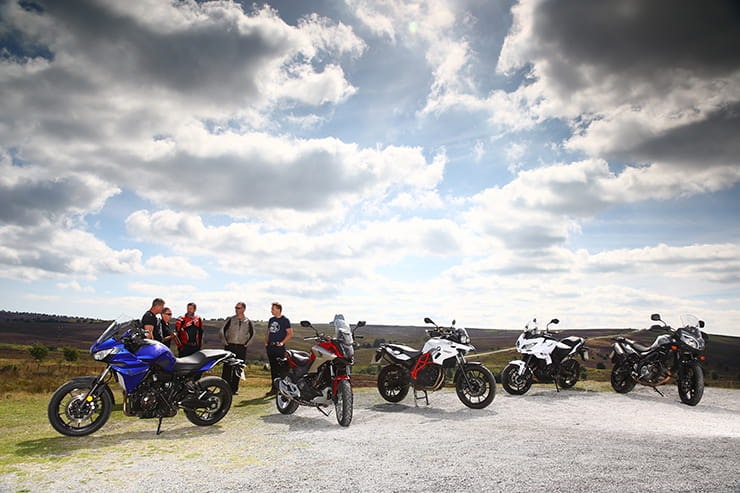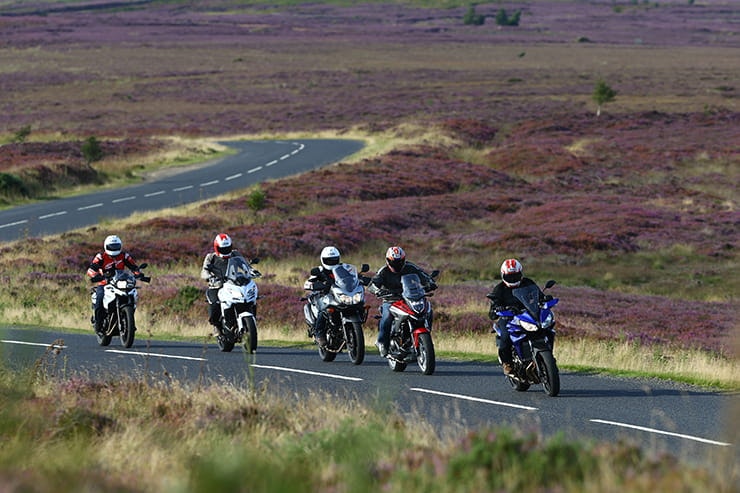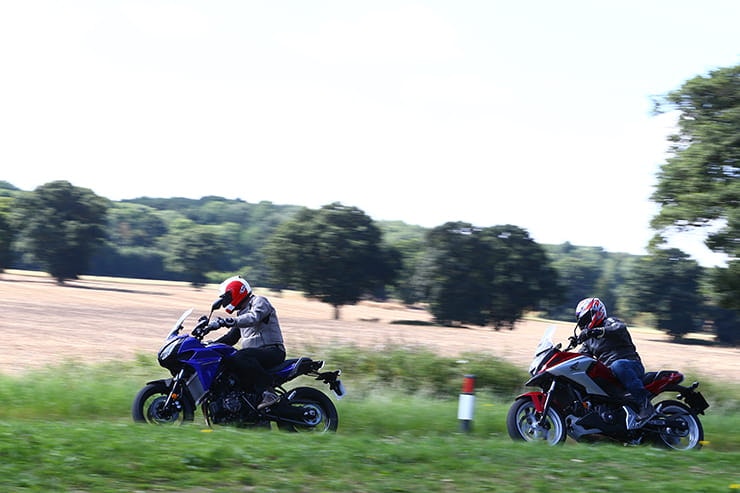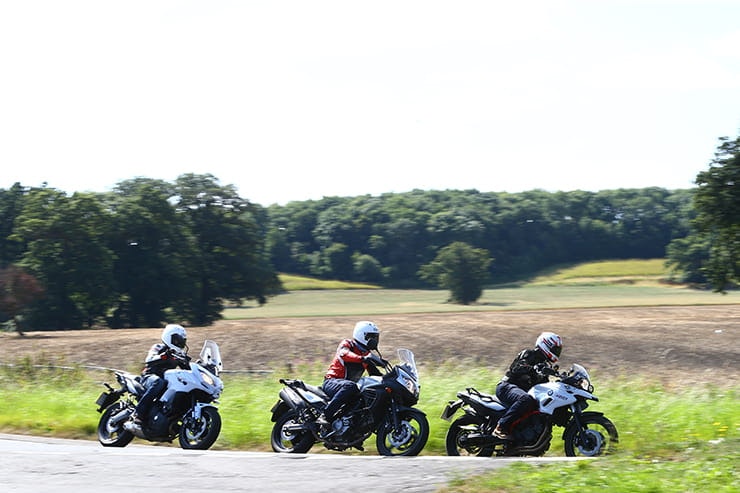Yamaha Tracer 700 vs Kawasaki Versys 650 vs Honda NC750X vs Suzuki V-Strom 650 v BMW F700GS Rallye | Middleweight Sports Tourers
By Phil West
Freelance journalist/editor/author
22.08.2016
It’s no surprise that, with the huge popularity of full-size adventure bikes – the latest group of which BikeSocial tested just the other week – more and more mid-size, more entry-level, affordable versions would follow.
Mid-range adventure bikes, if you like.
While BMW’s evergreen R1200GS continues to be a best seller and inspire a whole range of imitators, such as the new Ducati Multistrada Enduro, KTM’s 1290 Super Adventure or Triumph’s updated Tiger Explorer 1200; in the middleweight class, long-lived and popular adventure-styled all-rounders such as Suzuki’s V-Strom 650 no longer have things all their own way.
First, Kawasaki has continued to update and evolve its VStrom rival, the Versys 650, with a face-lifted and more refined version of the versatile parallel twin coming out last year.
At the same time, adventure bike pioneers BMW have constantly updated and expanded its family of F700 and 800 parallel twins.
But two new bikes have suddenly made the class more interesting and competitive than ever.
Honda’s deliberately novice-friendly NC750X might not be everyone’s cup of tea, thanks to its rather soft, unexciting demeanour, but there’s no denying its success: the low-revving twin, with novel ‘in tank’ luggage space and ‘DCT’ semi-automatic gearbox option, was Honda’s best-selling 125cc+ bike in Europe last year bar none thanks to its unintimidating behaviour allied to scoter-style practicality – and that was before they made it sharper looking and more dynamic for 2016.
And if that doesn’t whet your whistle, there’s another newcomer from the other end of the spectrum that promises excitement in spades.
Yamaha’s new Tracer 900, a semi-adventure-styled version of its already popular MT09, instantly became one of the UK’s best sellers when launched last year, enough to guarantee a similar conversion of its twin cylinder MT07 little brother.
The result; the brand new Tracer 700, with all the lively, sprightly fun of the MT, an almost-as-cheap price (at £6299) plus the added versatility and comfort its adventure style ergonomics and weather protection bring, promised to whisk the new Yamaha straight to the top of this increasingly competitive and compelling class.
But does it? To find out, BikeSocial decided to pit all five machines head-to-head on a medium-sized adventure of our own designed to reveal exactly what you get for your money with each. To get to the very heart of the matter, if you like. And how better to take in some serious A-roads, motorway miles, twisties and more, and all with an absolutely spectacular backdrop, than by undertaking a two-day, 400-mile mini-adventure from Peterborough to TV’s Heartbeat country – the North York Moors?
HERE'S THE VIDEO REVIEW:
Go North young man! Yamaha Tracer 700
With five bikes and riders (co-testers Michael Mann, Jon Urry, Bruce Dunn and Jamie Rule), some serious scratching miles ahead of us and just the one planned overnight stop (in the garrison town of Catterick on the edge of the North York Moors) we decided to travel light with rucksacks and do away the need for cumbersome, complicating luggage.
I decided to travel light with my first ride, too. I was already fairly familiar with most of the bikes here. I rode the benchmark old-stager, the VStrom, on its original press launch way back in 2011 and it’s proved a steady, if now a little old school, performer ever since. I’d also sampled the BMW (albeit in Adventure not this Rallye trim), on a tour of Wales, recently rode the new Versys up to Edinburgh and back and tested the updated Honda in Spain earlier in the year at the press launch.
I was new, however, to the much-anticipated Yamaha. And having ridden both its bigger brother, the Tracer 900, and the sprightly and willing naked MT07 upon which it’s based, was expecting great things.
There’s something both lean and mean and aggressively modern about the Tracer. All angular and asymmetric there’s no waste, no flab – in fact it looks so minimalist it’s almost as if some body panels have fallen off. It’s also undeniably modern and light, from its slimline LCD display to its stubby, underslung pipe – and it is. Waif-waisted and svelte, on board you feel like there’s virtually nothing between your knees. And with sharp, sporty steering and that punchy, instantly responsive twin at its heart, the Tracer is a traffic jam buster par excellence – perfect, in fact, for slicing through the outskirts of Peterborough.
Heading north on the sweeping A15 through Bourne and beyond reveals Yamaha to have achieved that rare blend of being both easy and instinctive to get on with (no novice should be in awe of the Tracer) and yet retain enough punch and dynamism to satisfy more experienced riders, too. That strummy, punchy twin is a gem: instant, willing and as lively as a puppy it’s also more credible than most as a sportster thanks to its fat tyres (clad impressively with Michelin’s new Pilot 3s) and half-decent suspension and brakes.
All that was true of the basic MT07, of course. Instead, what sets the Tracer apart is its more substantial proportions and long-distance appeal. The bigger tank (from 14 to 17 litres), new fairing and associated bodywork, make the Tracer ‘an MT07 with more’ without sacrificing any of that lithe ability. I rode the naked version to Norwich and back the other year and, though fun, felt exposed, weather-beaten and somehow diminutive throughout. On the Tracer it’d be a breeze.
It’s not perfect, though. That minimalist, budget appeal also results in the Yamaha feeling a little basic if not cheap in some areas. The new style switchgear is flimsy, the Meccano-like bar-brace plain odd, and its forks, though OK for most riders, are nowhere near as sophisticated or refined as, say, the Kawasaki’s – a factor speed tester Bruce and co-tester Jon were particularly critical of. Even so, at £6299, there’s no doubt the Yamaha is still a helluva lot of bike for the money…
To the Humber by Honda
After a bend-swinging photo-session amid the oak-speckled meadows just north of Osbournby, we swapped bikes for the first time, I switching to the updated Honda which had already impressed Jamie. ‘That DCT gearbox ain’t half clever,’ he said, revelling in the calm, easy magic carpet ride the semi-auto NC delivers. It is.
But this updated 2016 version is better yet. In silver and sweet wrapper red it might remind of a Quality Street but the sharpened up looks are a big improvement over the slightly beige and bland old version. Performance is improved, too, with sportier, sharper auto settings, new suspension, can and more. But there’s no denying it’s a bike that divides opinions.
Being the adventure-styled version of Honda’s optionally DCT-equipped NC family (along with the NC750S roadster and Integra), plus having 750 twin power and c.£7K price tag qualifies the NC for this comparo. But it remains the most leftfield bike here and one that some struggle to attune to.
On the A15 north towards Sleaford then Lincoln the Honda’s so effortless it’s like riding a maxi-scooter: thumb the starter, then with the same thumb prod into D for Drive, twist the throttle and away you go, easy as. The lumpy, low revving twin dialling in the gears more keenly if you then prod successively into Sport 1, Sport 2 or 3. But it’s a ‘maxi-scooter’ that looks and has the ergonomics of a proper motorbike.
As a motorbike, it’s decent enough, too. The semi-adventure bike riding position is very much in keeping with its rivals here; the clocks and build quality are typical and reassuringly Honda and though, with just 54bhp and softer cycle parts than most, the NC’s never as sharp or dynamic as the others the Honda still has enough to please, especially in isolation – and never gets left behind either. And for a bike that’s so phenomenally easy and unintimidating to ride, so novice friendly and so damn practical (due to its novel luggage compartment and massive economy), that’s what makes it so appealing and explains its success.
But the NC won’t be for everyone. A fuel stop just before the monumental Humber Bridge, when we initially struggle to find the filler (it’s under the seat, duh!), remind of its scooter roots. Repeatedly when setting off I find myself flailing for the non-existent clutch lever (perhaps that’s a testament to how convincing as a bike it is). And later, Jon in particular, is damning of the Honda’s weaker performance, softer brakes and suspension and, particularly, to his taste at least, the character of the auto ‘box.
For me, though and, I suspect for most, that’s like criticising an apple for not being an orange. No, the NC can’t match the edgy excitement and performance of the others here, but it has enough to please many, emphatically achieves what it sets out to and simply, cleverly, thanks to its unique features, delivers an unintimidating, easy ‘welcome to motorcycling’ experience like no other.
Suzuki VStrom: More into the Moors
All of which make the post-lunch switch to the Suzuki VStrom something of a culture shock.
Everyone knows the VStrom by now, surely. Introduced as a spin-off to the already massively successful SV650 in 2004, as a budget but brilliant, hugely versatile, all-round ‘first big bike’, the impressive V-twin, for years, had no equal. That success, of course, ensured the Suzuki wouldn’t have things its own way forever. Kawasaki’s first Versys parallel twin became the VStrom’s first credible rival in years. Others, like Triumph’s Tiger 800 and BM’s F650/700/800, claimed their own slices of the pie, albeit in a more expensive way, soon after.
All of which, along with ever-tightening Euro regs, prompted Suzuki’s introduction of this uprated (with the cleaner, Gladius version of the 647cc V-twin) and facelifted version in 2011 – and it had it all: Stylish, curvier looks and decent equipment that belied its budget tag; ‘3/4 adventure bike’ proportions that pretty much fitted everyone; ‘bike for all reasons’ versatility and, topping it all off, that thrummy, flexible and yet brisk and involving V-twin. In short, it was a brilliant, benchmark bike.
It still is. The trouble is, as we veered into the moors, began slicing and dicing between the sheep and dry stone walls and climbed up hill and down dale, there’s two slightly irksome problems with that. First and most conspicuously, time has moved on since 2011 and the Suzuki hasn’t. In this company the VStrom, irrespective of its still strong abilities, is undeniably now ageing and looking a little old. Apart from the BM, it’s the only one with a 19in front wheel; it’s posture is somehow ‘baggier’ and more laid back and, while reasonably equipped, it’s also somehow more ‘analogue’ compared to latest Yamaha, Kawa and BM.
Don’t get me wrong – the VStrom’s not a bad bike. Far from it. It’s still good enough to be considered the benchmark, the class standard, the machine all others have to beat. But though a great all-rounder – it always still impresses on that first re-introduction – and available in a variety of useful ‘packages’ and specifications (for example the more rugged VStrom XT at £7599) it doesn’t quite shine as brightly as it once did. It’s never the best at any one thing.
Maybe that wouldn’t matter if the Suzuki was still the bargain it once was – but it’s no longer that, either. At £6999 for the base version (and our test bike came with a few accessories such as crash bars that suggested it was even more than that) it’s a full £700 more than the newly-introduced Yamaha and £100 more than the fresher, better specced Kawasaki, too. And while I’m happy to admit the VStrom is still a great, useful bike, and one that’ll disappoint no-one, I can’t quite stomach that. Don’t forget, you could probably get a two-year-old 4000-miler that’s just as competent, for under £5K.
Kawasaki – Flying from Fylingdales
And the very fact that the Suzuki hasn’t been updated at all since 2011 is thrown into stark relief with any comparison to the Kawasaki Versys I switched to for our final blast of the day.
After a couple of hours on the very top of the Moors doing much of the photography you see here, with the secret radar installation of RAF Fylingdales on the horizon (no longer the famous ‘golf balls’, now a single, wedge-shaped installation), it was finally time for a dash to the hotel. It was already 8pm with the dusk sun racing towards the horizon; the sat nav said our destination was still an hour away and we suspected we’d be cutting it fine to have time to shower and eat. Time to motor.
And the Versys was arguably the best bike on which to do just that. Already a great machine before its 2015 makeover, the addition then of extra power, uprated, multi-adjustable suspension and new bodywork including a bigger 21-litre tank and more protective, adjustable screen took the Kawasaki to the very top of this class. In fact, it’s so good and so versatile, I wondered a year ago when taking the new version to Edinburgh and back, why anyone would want a litre-class adventure machine when this 650 was so good for a fraction of the price.
Simply put: the Versys just does it. Like the Suzuki, the Kawasaki is a slightly more ‘full-sized’ machine than the others but unless you’re extremely inexperienced or short, that’s a bonus not a burden. Also, like the Suzuki, it’s full-size comfortable (for two) and thoroughly equipped (although some criticised the fact the Versys was the only bike here without a gear indicator or hand guards). Thereafter, though, the Kawasaki edges ahead. Although the VStrom and Versys put out an identical 68bhp, the Kawasaki’s just that little bit newer and sharper. Its suspension and brakes are that little bit more refined; its weather protection (thanks to an adjustable screen) that touch better and, with a 17incher up front instead of the VStrom’s 19, combined with a firmer, more precise ride, the Kawasaki, as we blitzed the B-roads towards Darlington heading West, is just that little bit more assured, engaging and, well, fun.
And when you combine that Yamaha and BM-rivalling sporting ability with the Kawasaki’s comfort, specification and value (the Versys is the second cheapest bike here, £150 less than the Suzuki) you end with an overall package that’s hard to beat. As we blasted through the twilight towards, we thought, Catterick, then got lost and eventually droned the last 30minutes through the black, I wouldn’t have been on anything else.
BMW F700GS Rallye – homeward bound
Next morning, we headed back whence we’d cam, back onto the Moors towards the home of TV’s Heartbeat, Goathland, before the final blast south and it was time for BMW’s offering to display its mettle.
I’m no stranger, either, to the German’s firm’s F-series middleweight twins of which, it has to be said, there’s now a huge and somewhat confusing variety.
The F700GS is intended as the slightly softer, more novice-friendly and more affordable option from the F700/800 duo – although it’s actually 798cc, the same as the 800, and merely detuned to produce 10bhp less.
Even so, in this new-for-2016 ‘Rallye’ spec, there’s not really that much that’s soft or novice-friendly about the 700. I guess the special red frame should have been the giveaway that this is some semi-hardcore, testosterone-filled variant. Complete with hand guards, electronic damping adjustment (which allows you to change the damping setting of the rear shock on the move with a flick of a switch) and centre stand, the BM is not just more luxuriously equipped than most others here, it’s got more of a sporting bias, too. In fact, that punchy 75bhp allied to sharpish steering and cut-down screen made it, not just in my book, but in that of others, too, the sportiest bike of this bunch. In fact, as we fired through the Moors, there was definitely a sense that the BM was the most aggressive, the one that was almost more supermoto than adventure bike, the one intended for more experienced riders.
Which is fine if you’re after a sort of ‘middleweight HP2’, are a BM fan and revel in all the plush dealer experience and proven residuals that come with it, but there’s a couple of downsides to all that, too. First, as you might expect, there’s a price to pay for that premium feel: the BM is far and away the priciest of this bunch and a full two grand more than Yamaha’s newcomer. That’s not to be taken lightly. Second, the BM’s not much of an all-rounder, either. Although punchy and sharp, it’s also got the least weather protection and fairly marginal long distance comfort. When miles of dual carriageway loomed, the BM’s keys were the ones which were grabbed last.
Verdict
Which was why, when we finally finished lunch at Ferrybridge services and refuelled, it was Yamaha’s newcomer, the Tracer, which I chose for the final leg. That wasn’t because the Yamaha is the best – but because I wanted one final go to help make up my mind.
Instead, the reality is that all of these bikes are exceptional but in very different ways. Honda’s oddball, DCT equipped NC750X polarises opinion more than most, but there’s no denying it delivers what it set out to achieve and does so brilliantly. It’s as easy as a scooter but with much of the appeal of a bike and yet is also economical, affordable and well built. It might not be for motorcycling connoisseurs, but for novices or returnees, I can’t think of anything better.
The VStrom is as good as it’s ever been – surprisingly so. But it’s also now more than a little long in the tooth and it’s starting to show. If it was cheaper I’d mind less…
While the BM is surprisingly punchy, impressively equipped, effective and to all of our surprise the most ‘bad-ass’ bike of this bunch.
Which leaves the new Yamaha and the Versys. The Tracer is every bit as much fun, versatile and temptingly affordable as we thought it would be. At £6299 it’s the biggest bargain here. But that cheapness also shows in a few places, like the switchgear and suspension. Buy one and you won’t be disappointed, but it’s not the best all-round bike here.
That accolade goes to the Versys. In one sentence: the Kawasaki does it all: comfortable enough for two over distance; better equipped than most; among the best scratchers and with one of the best engines as well. Admittedly it might not be head and shoulders the best at any one thing, but it’s there or there about at everything and, at that price, it all makes the Kawasaki irresistible.
You’ve heard what we think. If you’re in the market, get yourself a test ride and let us know your own thoughts.
Fuel Consumption
Honda NC750X - 68mpg
Kawasaki Versys 650 - 57mpg
BMW F700GS Rallye - 55mpg
Yamaha Tracer 700 - 54mpg
Suzuki V-Strom 650 - 50mpg
Gallery
Pics: Chippy Wood. Video: Beach Media. Thanks to Wheels Motorcycles of Peterborough.



